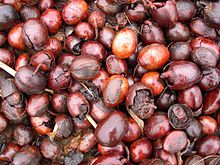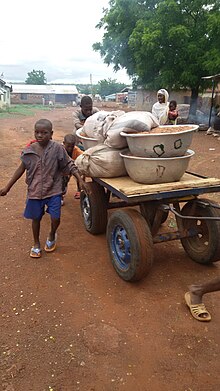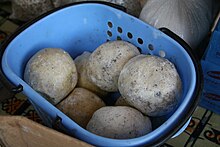Shea butter

Shea butter (/ˈʃiː/ or /ˈʃiː.ə/) is an off-white or ivory-colored fat extracted from the nut of the African shea tree (Vitellaria paradoxa).[1] Shea butter is a triglyceride (fat) derived mainly from stearic acid and oleic acid. It is widely used in cosmetics as a moisturizer, salve or lotion. Shea butter is edible and is used in food preparation in Africa.[2] Occasionally, the chocolate industry uses shea butter mixed with other oils as a substitute for cocoa butter, although the taste is noticeably different.[3][4]
The English word "shea" comes from s’í, the tree's name in the Bambara language of Mali.[5] It is known by many local names, e.g., karité in the Wolof language of Senegal,[6] ori in some parts of West Africa, and many others.[7][8]

History
Accounts from as early as Cleopatra's Egypt speak of caravans bearing clay jars of valuable shea butter for cosmetic use. The funeral beds of early kings were carved in the wood of shea trees. Shea butter's skin care and healing properties were first harnessed thousands of years ago. The history of shea as a precious commodity can be traced back to Ancient Egypt, where shea butter was and continues to be used to protect the hair and skin against the fierce sun and the hot dry winds of African deserts and savannah.[9][unreliable source?]
Butter extraction and refining
This section needs additional citations for verification. (June 2014) |
The traditional method of preparing unrefined shea butter consists of the following steps:[10]


- Separating/cracking: The outer pulp of the fruit is removed. When dry, the nut, which is the source of shea butter, must be separated from the outer shell. This is a social activity, traditionally done by women elders and girls who sit on the ground and break the shells with small rocks.
- Crushing: To make the shea nuts into butter, they must be crushed. Traditionally, this is done with mortars and pestles. It requires lifting the pestles and grinding the nuts into the mortars to crush the nuts so they can be roasted.
- Roasting: The crushed nuts are roasted in huge pots over open wood fires. The pots must be stirred constantly with wooden paddles so the butter does not burn. The butter is heavy and stirring it is hot, smoky work, done under the sun. This is where the slight smoky smell of traditional shea butter originates.
- Grinding: The roasted shea nuts are ground into a smoother paste; water is gradually added and the paste is mixed well by hand.
- Separating the oils: The paste is kneaded by hand in large basins and water is gradually added to help separate out the butter oils. As they float to the top, the butter oils, which are in a curd state, are removed and excess water squeezed out. The butter oil curds are then melted in large open pots over slow fires. A period of slow boiling will evaporate any remaining water.
- Collecting and shaping: The shea butter, which is creamy or golden yellow at this point, is ladled from the top of the pots and put in cool places to harden. Then it is formed into balls.
Industrially, a mechanical sheller such as the universal nut sheller may be used. The refined butter may be extracted with chemicals such as hexane or by clay filtering.
Composition and properties
Shea butter extract is a complex fat that in addition to many nonsaponifiable components (substances that cannot be fully converted into soap by treatment with alkali) contains the following fatty acids: oleic acid (40-60%), stearic acid (20-50%), linoleic acid (3-11%), palmitic acid (2-9%), linolenic acid (<1%) and arachidic acid (<1%).[11]
Shea butter melts at body temperature. Proponents of its use for skin care maintain that it absorbs rapidly into the skin, acts as a "refatting" agent, and has good water-binding properties.[12]
Uses

Shea butter is mainly used in the cosmetics industry for skin- and hair-related products (lip gloss, skin moisturizer creams and emulsions, and hair conditioners for dry and brittle hair).[citation needed] It is also used by soap makers, typically in small amounts (5-7% of the oils in the recipe), because it has plenty of unsaponifiables.[citation needed]
In some African countries such as Benin, shea butter is used for cooking oil, as a waterproofing wax, for hairdressing, for candle-making, and as an ingredient in medicinal ointments. It is used by makers of traditional African percussion instruments to increase the durability of wood (such as carved djembe shells), dried calabash gourds, and leather tuning straps.[citation needed]
Shea butter can be an ingredient of organic broth.[13]
In the UK and other countries, it is incorporated into assorted tissue products, such as toilet paper.[14]
Medicinal
Shea butter is sometimes used as a base for medicinal ointments. Some of the isolated chemical constituents are reported to have anti-inflammatory,[15] emollient and humectant properties.[citation needed] Shea butter has been used as a sunblocking lotion and has a limited capacity to absorb ultraviolet radiation.[3]
In Ghana, shea butter, locally known as nkuto (Akan) or nku (Ga) is applied as lotion to protect the skin during the dry Harmattan season.[6]: p.8
In Nigeria shea butter is used for the management of sinusitis and relief of nasal congestion.[16] It is massaged into joints and other parts of the body where pain is experienced.[citation needed]
Classification
The United States Agency for International Development and other companies[17] have suggested a classification system for shea butter separating it into five grades:
- A (raw or unrefined, extracted using water)
- B (refined)
- C (highly refined and extracted with solvents such as hexane)
- D (lowest uncontaminated grade)
- E (with contaminants).
Commercial grades are A, B, C. The color of raw (grade A) butter ranges from cream (like whipped butter) to grayish yellow. It has a nutty aroma which is removed in the other grades. Grade C is pure white.[citation needed] While the level of vitamin content can be affected by refining, up to 95% of vitamin content can be removed from refined grades (i.e., grade C) of shea butter while reducing contamination levels to non-detectable levels.[citation needed]
See also
- Shea nut and butter production in Burkina Faso
- Shea Yeleen, a social enterprise that trains women-owned shea butter cooperatives
- List of butters
References
- ^ Alfred Thomas (2002). "Fats and Fatty Oils". Ullmann's Encyclopedia of Industrial Chemistry. Weinheim: Wiley-VCH. doi:10.1002/14356007.a10_173.
- ^ National Research Council. Lost Crops of Africa: Volume II: Vegetables (2006). ISBN 978-0-309-10333-6.
- ^ a b E. T. Masters, J. A. Yidana and P. N. Lovett. "Reinforcing sound management through trade: shea tree products in Africa".
- ^ Fold, N. 2000. "A matter of good taste? Quality and the construction of standards for chocolate in the European Union. Cahiers d'Economie et Sociologie Rurales, 55/56: 92–110" (PDF).
{{cite web}}: CS1 maint: numeric names: authors list (link) - ^ "Reference.com Dictionary Entry". Retrieved 25 August 2012.
- ^ a b Goreja, W. G. (2004). "Chapter 2". Shea Butter: The Nourishing Properties of Africa's Best-Kept Natural Beauty Secret. TNC International. p. 5. ISBN 9780974296258.
{{cite book}}: Cite has empty unknown parameters:|editorn-first=and|editorn-last=(help) - ^ "Shea Butter". Retrieved March 7, 2013.
- ^ "Ori Shea Butter". Retrieved March 7, 2013.
- ^ W.G. Goreja (2004). Shea Butter: The Nourishing Properties of Africa's Best-Kept Natural Beauty. Amazing Herbs Press. p. 41. ISBN 0-9742962-5-2.
- ^ Yézouma Coulibaly, Stéphane Ouédraogo and Nathalie Niculescu. "Experimental Study of Shea Butter Extraction Efficiency Using A Centrifugal Process" (PDF). Asian Research Publishing Network.
- ^ Davrieux, F., Allal, F., Piombo, G., Kelly, B., Okulo, J. B., Thiam, M., Diallo, O. B. & Bouvet, J.-M. (2010). "Near Infrared Spectroscopy for High-Throughput Characterization of Shea Tree (Vitellaria paradoxa) Nut Fat Profiles. Journal of Agricultural and Food Chemistry, 58, 7811-7819".
{{cite web}}: CS1 maint: multiple names: authors list (link) CS1 maint: numeric names: authors list (link) - ^ Hemat, R. A. S. (2003). Principles of Orthomolecularism. Urotext. p. 160. ISBN 9781903737057.
{{cite book}}: Cite has empty unknown parameters:|editorn-first=and|editorn-last=(help) - ^ Natur Kompagnie
- ^ [1]
- ^ Akihisa, T.; Kojima, N.; Kikuchi, T.; Yasukawa, K.; Tokuda, H.; Masters, E. T.; Manosroi, A.; Manosroi, J. (2010). "Anti-inflammatory and chemopreventive effects of triterpene cinnamates and acetates from shea fat". Journal of Oleo Science. 59 (6): 273–80. doi:10.5650/jos.59.273. PMID 20484832.
- ^ Tella, A, Br (1979). "Preliminary studies on nasal decongestant activity from the seed of the shea butter tree, Butyrospermum parkii". J Clin Pharmacol. 7 (5): 495–497. doi:10.1111/j.1365-2125.1979.tb00992.x.
{{cite journal}}: CS1 maint: multiple names: authors list (link) - ^ United States Agency For International Development, October 2006. "Buying and Selling Shea Butter: A Marketing Manual for West Africa" (PDF).
{{cite web}}: CS1 maint: numeric names: authors list (link)
